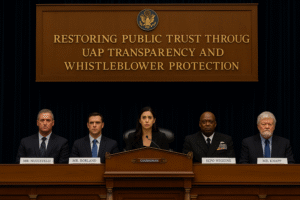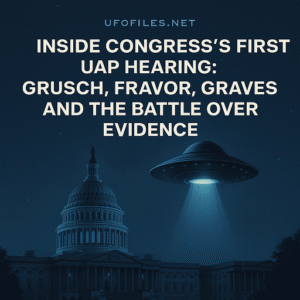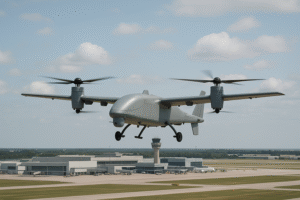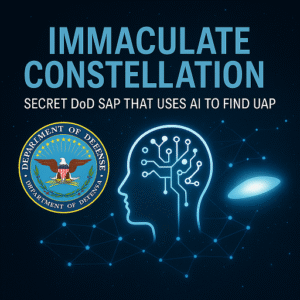On September 9, 2025, Congress held a landmark public hearing titled Restoring Public Trust Through UAP Transparency and Whistleblower Protection. Hosted by the Task Force on the Declassification of Federal Secrets under the House Oversight Committee, the session began at 10:00 AM ET in HVC-210 at the U.S. Capitol.
The focus: transparency around unidentified anomalous phenomena (UAP), strengthening whistleblower protections, and reducing over-classification by agencies like the Department of Defense (DoD) and the All-Domain Anomaly Resolution Office (AARO).
Opening Statement – Rep. Anna Paulina Luna
Chairwoman Rep. Anna Paulina Luna (R-FL) opened strongly, declaring:
“For too long, the issue of Unidentified Anomalous Phenomena has been shrouded in secrecy, stigma, and in some cases outright dismissal” (Oversight Committee statement).
She framed the issue as a matter of accountability:
“This is about national security, government accountability, and the American people’s right to the truth.”
Luna attacked restrictive classification protocols:
“Congress has been hindered by special access programs that prevent even Members of Congress from exercising oversight … What the American people cannot tolerate is a government that withholds the truth and punishes those who dare to speak out.”
She also singled out Sean Kirkpatrick, the former AARO director:
“Recently, the former AARO director, known as Sean Kirpatrick, attacked our witnesses and members on this committee. It should be noted that he is a documented liar … what was his purpose at AARO really — if it was not to follow up on investigations and disclose his findings to Members of Congress” (Oversight Committee remarks).
Luna referenced former Pentagon official Chris Mellon, who called AARO’s official report dismissing UAP as “the most error-ridden and unsatisfactory government report” he had seen. The report, she noted, lacked sign-off from the Director of National Intelligence and excluded major UAP scholars.
Witnesses
Four witnesses testified under oath:
-
Jeffrey Nuccetelli, U.S. Air Force veteran
-
Dylan Borland, U.S. Air Force veteran
-
Senior Chief Alexandro Wiggins, U.S. Navy
-
George Knapp, investigative journalist
The session also featured Rep. Eric Burlison (R-MO), who introduced previously unseen UAP footage.
Jeffrey Nuccetelli (Air Force veteran)
Nuccetelli opened by invoking the emotional and existential impact his encounters had:
“What we saw changed our lives — the way we think about everything. It was incredibly profound.”
“Each incident was witnessed by multiple personnel, documented, investigated and reported up the chain of command. We sent information up, but we got no guidance down on how to handle these events.” (DefenseScoop)
He referred to five separate unexplained incidents between 2003 and 2005 around Vandenberg Air Force Base (now Vandenberg Space Force Base), during times when sensitive launches were underway nearby (The Independent, DefenseScoop).
He argued for stronger support and protections:
“Transparency is the foundation of truth. Without it, witnesses like us are dismissed. Protect the witnesses. Many stay silent out of fear for their careers, reputations, and the safety of their families.” (House Oversight Committee, Rev transcript)
In media coverage, he described the Vandenberg objects as “massive … like flying buildings” that pulsed or moved unnervingly, and said they repeatedly failed standard explanations (DefenseScoop).
He used his own experiences to frame broader policy asks: more funding for independent research, dismantling overclassification, and legal protections for those who speak up (Rev transcript, DefenseScoop).
Dylan Borland (Air Force veteran)
Borland’s testimony was more centered on personal cost, retaliation, and classified program knowledge.
“Because of my direct knowledge of the reality of certain legacy UAP programs, my professional career was deliberately obstructed. I have endured sustained reprisals from government agencies for more than a decade.” (DefenseScoop)
He claimed that after reporting a 2012 UAP event at Langley Air Force Base, his access to classified work and career progression were curtailed. He also alleged harassment, withholding of assignments, and obstacles to operating in security-cleared roles (DefenseScoop, Rev transcript).
He described the emotional toll: feeling “discarded, isolated, hopeless, separated from the country they serve” (House Oversight Committee).
Though constrained by classification rules himself, he said he knew of legacy UAP programs that he could not fully explain in public, pointing to structural secrecy as a barrier to understanding (DefenseScoop, Rev transcript).
His presence helped highlight that whistleblowers risk institutional retaliation—not just skepticism.
Senior Chief Alexandro Wiggins (U.S. Navy)
Wiggins’s testimony is perhaps the most technically specific and daring, since he is (or was) active-duty when the event occurred.
In his introduction, he laid out that he was testifying personally (not on behalf of the Navy or DoD) (Rev transcript).
He recounted a 2023 incident aboard the USS Jackson:
“A Tic Tac-shaped, self-luminous object emerged from the ocean and joined three others … They had no signatures of conventional propulsion and produced no sonic boom.” (Rev transcript, DefenseScoop, House Oversight Committee)
He pushed for improvements in the field to make future encounters yield higher-grade data:
“Aviation and maritime safety: when crews and watchstanders observe objects that maneuver or accelerate in ways that do not match known profiles … that is first and foremost a safety issue. Standardized checklists and training should ensure we capture the best possible sensor data in real time … and immediate change of chain of custody for any recordings.” (House Oversight Committee)
He stressed the need for non-retaliation channels:
“Reporting without stigma, protection without retribution. Sailors need to know that reporting UAP encounters will not harm their careers.” (House Oversight Committee)
In effect, Wiggins’s testimony framed this as both a technical intelligence issue and a personnel/institutional challenge: you need skilled observers, good sensors, clear protocols, and safe reporting.
George Knapp (Investigative Journalist)
Knapp’s role was more big-picture, pointing to internal documents, press suppression, and how the public narrative diverges from what insiders know.
He opened forcefully:
“The public has been told over and over since the late 40s, ‘there’s nothing to worry about here.’ … The documents paint a much different picture than what the public, the press, and Congress have been told over many years.” (House Oversight Committee, Rev transcript)
He argued that military and intelligence insiders admit anomalous craft exist and outperform known technology:
“These things outperform any aircraft known to exist, including ours.” (House Oversight Committee)
He also lamented how whistleblowers are treated:
“Men who have seen strange things and stepped forward … are routinely insulted, belittled, or worse. They risked their reputations, their careers, their clearances … sometimes, even their freedom.” (House Oversight Committee, Rev transcript)
Knapp further claimed that many more videos and files exist (in government vaults) that Congress and the public are blocked from seeing, implying active suppression:
“There’s a server where there’s a whole bank of these kinds of videos that Congress has not been allowed to see — that the public has not been allowed to see.” (The Independent)
He tied this into a narrative of institutional denial: the public line (dismissal, skeptics) diverges from internal acknowledgment (House Oversight Committee).
Luna, Kirkpatrick, & Closing Moments
One detail the first version under-emphasised: in her opening, Luna personally criticized former AARO director Sean “Kirkpatrick”, calling him a “documented liar,” and implying his actions conflicted with congressional mandates. She accused him of attacking witnesses and undermining the committee (House Oversight Committee, Rev transcript).
Here’s the fuller passage from her prepared remarks:
“Recently, the former AARO director, known as Sean Kirpatrick, attacked our witnesses and members on this committee. It should be noted that he is a documented liar … what was his purpose at AARO really — if it was not to follow up on investigations and disclose his findings to Members of Congress.” (Oversight Committee)
She asserted that his report to Congress (via AARO) was deeply flawed. Luna cited Chris Mellon (former Deputy Assistant Secretary of Defense for Intelligence), who described AARO’s official report (that found no evidence of UAP representing extraterrestrial technology) as “the most error-ridden and unsatisfactory government report” he had seen in decades. Luna noted that the report lacked DNI sign-off and excluded contributions from major UAP scholars (Oversight Committee).
As for her closing moment, the official Oversight wrap-up doesn’t show Luna delivering a dramatic closing speech after each witness. The record indicates the session adjourned after all testimony, without a formal “Luna closing statement” beyond motions to adjourn (Rev transcript, House Oversight Committee).
That said, in many reports and in her opening she framed the hearing’s stakes in closing-tone language. For example, she repeated:
“Whether UAPs represent adversarial technology, natural phenomena, or something beyond current human understanding, Congress has a responsibility to investigate.” (House Oversight Committee, Rev transcript)
And the wrap-up from the Oversight Committee echoed her themes: that Americans demand oversight, classification rules must reform, and whistleblowers need shields (House Oversight Committee).



